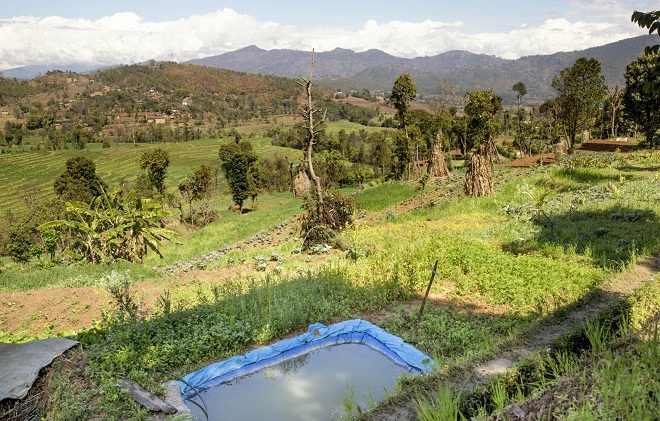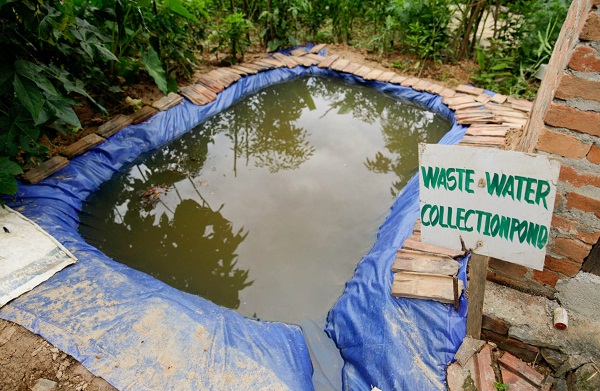Rural Nepali people, who are investing in and implementing climate-smart practices, offer examples for Asian countries to learn and engage in climate-smart activities
By Sana Jamal
KATHMANDU, Nepal – “It was after getting this plastic pond that we were able to have enough water for irrigation and to feed our animals. But we still are looking for some longtime solution for drinking water” says Geeta Kuikel, a women farmer in Nepal.
In Bas Pokhari village, a two and a half hour drive along bumpy roads from Kathmandu, Geeta Kuikel’s family is not the only one facing severe water scarcity. Drying water sources and ground water depletion is one of the major problems in Nepal caused by long dry seasons and irregular rainfall, which the experts say is part of changes in climate.
Around 50 per cent of Nepal’s 27 million people live in mountains and communities in hills of Nepal are at the frontline of the problem. More or less similar problems are faced by people living in Himalayan countries including Pakistan.
Until couple of years ago, Geeta Kuikel, 52, had to walk one and a half hours each day to get drinking water. Now there are water taps in the village but there are still severe water shortages. “One water-tap is used by at least 6 families and the water is never enough” says Sudarshan Kuikel, Geeta’s husband. The tap water comes from a nearby spring but “after the earthquake the water springs in the village are drying up fast”.
Sudarshan is talking about the Earthquake in April 2015 which caused more than 9000 deaths and destroyed hundreds of thousands of houses. The earthquake brought in new problems for the rural Nepali people. But some have been clever enough to invest in and implement climate smart practices introduced by the government and local NGOs.
Plastic ponds for water conservations are one of the many techniques being adopted by farmers to conserve water. One plastic pond (about 1 meter deep) store rainwater and kitchen water and save up to 15,000 liters which is then used for irrigation and feeding animals. Geeta is happy that the pond water is enough for the animals and crops but still has one more worry on her mind. “Now the only worry is to arrange enough water for drinking” she says.
Chitram is a farmer in his 60s. “When I was young, I saw more rivers and streams around the village which are not visible anymore” he said. Local climate research organizations back up Chitram’s observation. “There were 60 water sources in the area 10 years ago and now there are only 21 because of erratic rainfall patterns” says Nanu Ghatani, one woman community leader.

Climate Smart Nepal
The Centre for Environmental and Agricultural Policy Research, Extension and Development (CEAPRED), a local NGO, with support from the International Centre for Integrated Mountain Development (ICIMOD), is helping farmers to adopt climate-smart practices. These agencies have launched pilot projects by establishing Climate Smart Villages (CSV) in various areas under the programme, Himalayan Climate Change Adaptation Program (HICAP).
Keshab Datta Joshi, program Director at CEAPRED says the mission of the organization is to educate people so that they can earn maximum benefit of their limited resources. Water conservation practices introduced are plastic ponds, drip irrigation, sprinkle irrigation, and training for people on waste water collection from rainwater, kitchen and washing water. NGOs provide the equipment such as plastic pond, jars and villagers provide labour to employ climate-smart practices.
“We demonstrate the idea to one family in one village then they adopt and train others. That is how the idea has spread to 500 households in climate smart villages in the area.”
One small pond is enough to irrigate 500 square meters of the area. The small pond that can store 5000 liters cost 1000 Nepali Rupees (NR) while the big pond that can store over 10,000 liters and cost 10,000 NR.
Krishna Dhital, a government agriculture extension officer said “these technologies are not new to the government but the only difference is that these organizations are focused on climate change and work intensively in poor regions while the government is working in all regions to improve the overall status of farmers.”
Other climate-smart practices being implemented include soil management practices, cropping smart practices, energy efficient methods and technological innovations.

Plastic Ponds – Cost-effective method of water conservation
A study conducted by Kochi Technology University (KTU), Japan, found plastic ponds to be a cost-effective method of adaptation used in various geographical settings. Using plastic pond as water harvesting technology “is expected to contribute to poverty reduction for smallholder farmers.” The vegetable production and income can increase by 33 per cent if a simple water conservation technique like lining ponds with plastic is deployed, according to the study which surveyed more than 1,000 Nepali farmers.
Lesson for Pakistan and South Asia
Nepal’s climate-smart practices can be implemented by other Asian countries like Pakistan which is now the world’s third most water-stressed country – a term that means most people don’t have proper access to potable water.
Community leaders and policy makers in Pakistan can learn and adopt the measures being implemented in Nepal’s climate smart villages to deal with water scarcity and water mismanagement issues.
Implementing climate-smart practices is certainly making a difference to people like Geeta Kuikel.

